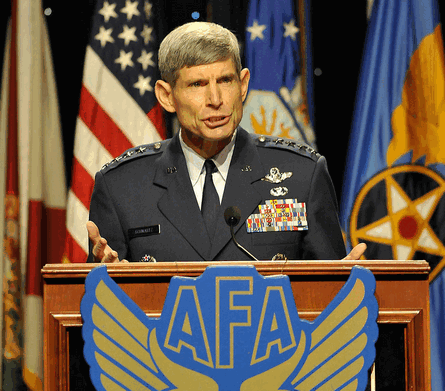Concerns about the aerospace industrial base are likely to guide major aircraft recapitalisation decisions under the US Air Force's new leadership.
Since 2006, the USAF has voiced its desire to yoke the demise of Lockheed Martin F-22 production with the start of full-rate production of the F-35 Lightning II Joint Strike Fighter (JSF). Indeed, Lockheed's JSF programme officials are expecting the air force to fill the gap by more than doubling purchases of F-35As after fiscal year 2012 from 48 to 110 aircraft per year.
Air Force chief of staff General Norton Schwartz has confirmed his support for this policy, and also expanded it. Schwartz says the same approach should be used for the airlifter industrial base, so that the duration of C-17 production should be linked to a full-rate order for a next-generation airlifter or tanker.
"It's important to have a production line that is hot," Schwartz says. "It is my personal view that there is a legitimate argument that there should be a hand-off between these production lines."
|
|---|
After the KC-X recompetition was cancelled on 9 September, Schwartz estimates it could take between eight and 48 months to sign a new contract to buy tankers. It is unclear how long it would take after contract signing to reach full-rate production.
General Arthur Lichte, chief of Air Mobility Command, says he prefers to restrict KC-X competition next year to the Boeing KC-767 and Northrop Grumman/EADS North America KC-30. If the rivals were allowed to change platforms, the timing of contract award could be dramatically extended.
Meanwhile, Boeing is currently on contract to complete delivery of 190 C-17s by 2009 and is likely in October to receive an additional order to deliver 15 more in 2010. The USAF has not requested funds to buy new C-17s for two straight years, instead relying on Congress and relatively small orders from foreign customers to fill the funding gap.
In the past, Schwartz has expressed support for ordering no more than 205 C-17s unless the service is allowed by Congress to start retiring its fleet of 60 Lockheed Martin C-5As.
The USAF is also awaiting the results of two major studies to determine its need for airlifters. Congress has commissioned a study from the Institute for Defense Analyses that is due in October. A mobility capabilities study, assessing airlift needs through 2016, is expected in mid-summer 2009.
In the long term, the Boeing C-17B, Airbus A400M and widened "XL" version of the C-130 are being prepared to compete for a USAF contract that may emerge after 2015. The immediate focus is meeting a niche airlift requirement driven by the Army Future Combat Systems, but each of the bidders is eyeing the larger requirement to start replacing about 221 C-130Hs in the USAF fleet from 2020.
However, there is an alternative to filling all capability gaps with new-generation equipment. In the case of fighters, one approach being discussed is for the USAF to continue buying some F-22s and abolish or drastically reduce purchases of the F-35A - using conventional fighters such as the F-15 and F-16 as a replacement.
Source: Flight International

















